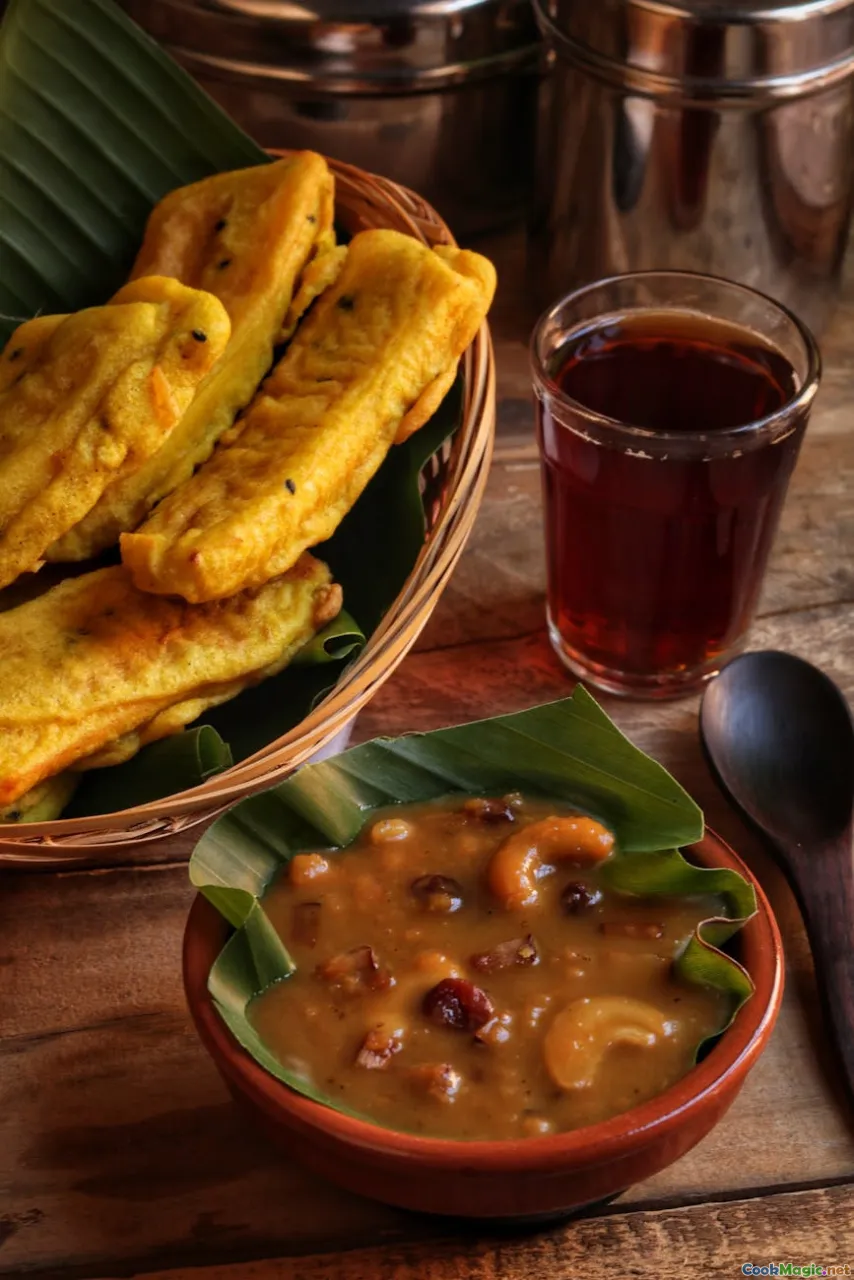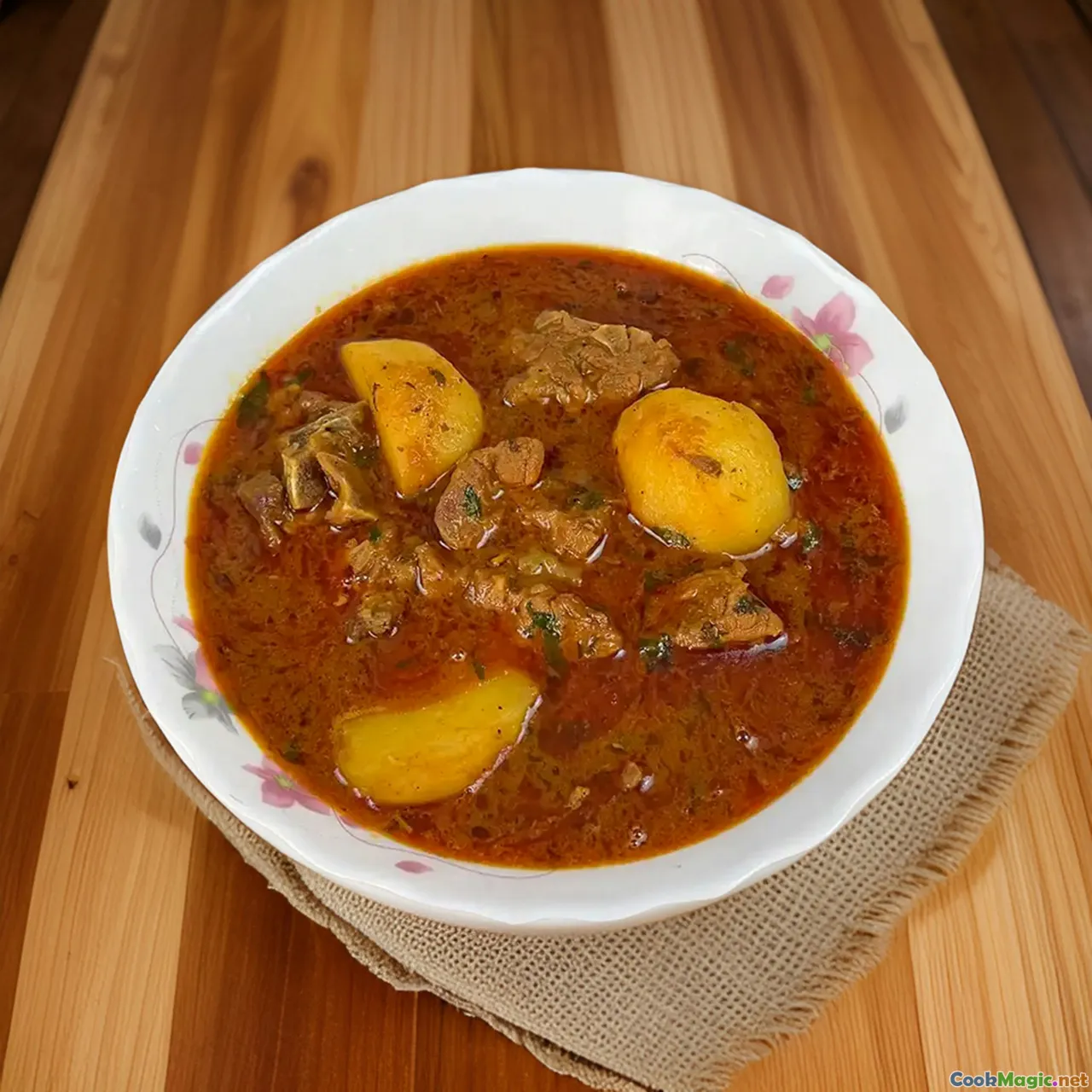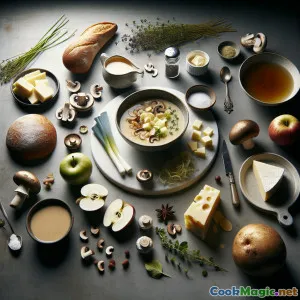
마투케 수확 냄비: 우간다 플랜테인 스튜
(Matooke Harvest Pot: Ugandan Plantain Stew)
(0 리뷰)재료
-
6 large 마투케(초록색 요리용 바나나)
(Peeled and sliced thickly)
-
3 medium 토마토
(주사위 모양으로 자른)
-
1 large 적양파
(잘게 썬)
-
2 medium 당근
(동그랗게 썰어낸)
-
1 large 단고추 (피망)
(Seeded and diced)
-
1 tbsp 신선한 생강
(갈은)
-
3 cloves 마늘
(다진)
-
1/4 cup 신선한 고수(실란트로)
(다진, 장식용)
-
2 tsp 커리 가루
(Mild or spicy, to taste)
-
2 tbsp 식물성 기름
(Sunflower or canola preferred)
-
700 ml 채소 육수
(Can substitute chicken broth for non-vegetarian)
-
1/2 tsp 강황 가루
(For color and mild earthiness)
-
1 tsp 소금
(취향에 따라)
-
1/2 tsp 흑후추
(Freshly ground, or to taste)
-
1 tbsp 레몬 주스
(Added before serving)
-
200 grams 강낭콩 (Kidney 또는 버터빈)
(Cooked, for extra protein)
(Peeled and sliced thickly)
(주사위 모양으로 자른)
(잘게 썬)
(동그랗게 썰어낸)
(Seeded and diced)
(갈은)
(다진)
(다진, 장식용)
(Mild or spicy, to taste)
(Sunflower or canola preferred)
(Can substitute chicken broth for non-vegetarian)
(For color and mild earthiness)
(취향에 따라)
(Freshly ground, or to taste)
(Added before serving)
(Cooked, for extra protein)
영양 정보
- 인분: 4
- 1인분 크기: 1 bowl (approximately 350g)
- Calories: 350 kcal
- Carbohydrates: 65 g
- Protein: 7 g
- Fat: 7 g
- Fiber: 10 g
- Sugar: 15 g
- Sodium: 760 mg
- Cholesterol: 0 mg
- Calcium: 75 mg
- Iron: 1.8 mg
조리법
-
1 - Prepare Ingredients:
Thoroughly peel the matooke, slice into thick rounds and set aside in water (to prevent browning). Chop all the vegetables and rinse beans if using.
-
2 - Sauté Aromatics:
Heat vegetable oil in a large pot over medium heat. Add onions and sauté until translucent, then stir in garlic and ginger for 1 minute until fragrant.
-
3 - Develop Flavor:
Add curry powder, turmeric (if using), and black pepper to the onion mixture, stirring for another minute to release the flavors.
-
4 - Add Vegetables:
Add diced tomatoes, sweet pepper, and carrots. Sauté until tomatoes soften and mixture becomes thick, about 5–7 minutes.
-
5 - Simmer with Matooke:
Add sliced matooke and stir to coat in the flavor base. Pour in vegetable broth, add beans (if using), and bring to a simmer. Cook uncovered on medium-low, stirring occasionally, until matooke is fork-tender and the stew thickens.
-
6 - Season and Serve:
Taste and adjust salt. Stir in lemon juice if desired. Garnish with fresh coriander and serve hot.
Thoroughly peel the matooke, slice into thick rounds and set aside in water (to prevent browning). Chop all the vegetables and rinse beans if using.
Heat vegetable oil in a large pot over medium heat. Add onions and sauté until translucent, then stir in garlic and ginger for 1 minute until fragrant.
Add curry powder, turmeric (if using), and black pepper to the onion mixture, stirring for another minute to release the flavors.
Add diced tomatoes, sweet pepper, and carrots. Sauté until tomatoes soften and mixture becomes thick, about 5–7 minutes.
Add sliced matooke and stir to coat in the flavor base. Pour in vegetable broth, add beans (if using), and bring to a simmer. Cook uncovered on medium-low, stirring occasionally, until matooke is fork-tender and the stew thickens.
Taste and adjust salt. Stir in lemon juice if desired. Garnish with fresh coriander and serve hot.
마투케 수확 냄비: 우간다 플랜테인 스튜 :에 대한 자세한 정보
Matooke Harvest Pot: The Heart of Ugandan Home Cooking
Matooke Harvest Pot is a celebratory, warming stew deeply rooted in Ugandan culture—and a quintessential experience for anyone seeking to explore the heart of East African cuisine. At its core, this dish relies on "matooke", a unique variety of cooking banana endemic to Uganda’s highlands, which transforms during extended simmering into a creamy and lightly sweet comfort food. While plantains can be used elsewhere, true matooke has a subtler flavor and a remarkable capacity to absorb and meld savory spices.
History and Cultural Significance
In Uganda, matooke is not just an ingredient—it's an institution. For centuries, it has served as a hearty foundation for the daily diet, especially among the Baganda people. Traditionally, matooke is peeled, wrapped in banana leaves, then steamed until tender and mashed, often accompanied by a mild stew. My version melds this tradition with communal stew-making: the "pot" approach allows for versatility, the addition of other harvest vegetables, and accommodates both contemporary busy lives and family gatherings.
Going beyond its humble reputation, matooke dishes are often present at festive occasions—weddings, family reunions, and public feasts—symbolizing abundance, hospitality, and the link to the land. The harvest season is savored together in large community pots like this one, using whatever fresh produce is at hand.
Unique Aspects & Adaptability
What makes the Matooke Harvest Pot unique among stews is its texture:
- As the thick-cut matooke simmers, it soaks up aromatic tomato, attains an earthy warmth from turmeric and curry, and ultimately breaks down to immaculate softness, thickening the broth into something akin to a light risotto.
- Unlike soups, you want a jab of fork or spoon to encounter pillowy pieces amidst the broth, not liquid alone or a fine mash.
Because matooke is relatively mild beyond its unique flavor, the recipe embraces tweaks and improvisation. Beans for protein, sweet pepper for color, whatever’s fresh from your market garden! The lemon finish brightens the pot just before serving, a gentle nod to east African flavor balances.
Tips and Notes:
- Matooke vs. Plantain: If outside Africa and matooke is unobtainable, green (unripe) plantains work almost as well—just avoid ripe bananas or sweet plantains.
- Avoid Discoloration: Peeled matooke browns quickly. Drop cut pieces immediately into water with a bit of lemon or vinegar to minimize this.
- Make It Protein-Rich: If vegetarian, toss in any cooked beans (kidney, white, or cowpeas). Meat eaters sometimes enrich the broth with smoked fish or goat, hearty in true Ugandan style.
- Meal served communal-style: For a shared experience, serve directly from pot at the table, encouraging everyone to help themselves. It fosters the same spirit of abundance and friendliness Kenyan and Ugandan cuisine celebrates.
Evolving Tradition
Few African dishes allow for so much of what grows nearby to shine, what flavors you have on hand, or what you wish to share. Ultimately, the Matooke Harvest Pot is comfort food that’s simple to assemble, yet radiant with the spirit of sharing, flexibility, and homespun warmth. Serve it alongside hot chapati or simple steamed green vegetables to experience real Ugandan hospitality.
Whether you’re exploring new worlds from your own table, reducing meat intake, or honoring food memories from another continent, this recipe is hearty, nourishing and ever adaptable—the mark of a truly beloved dish.























